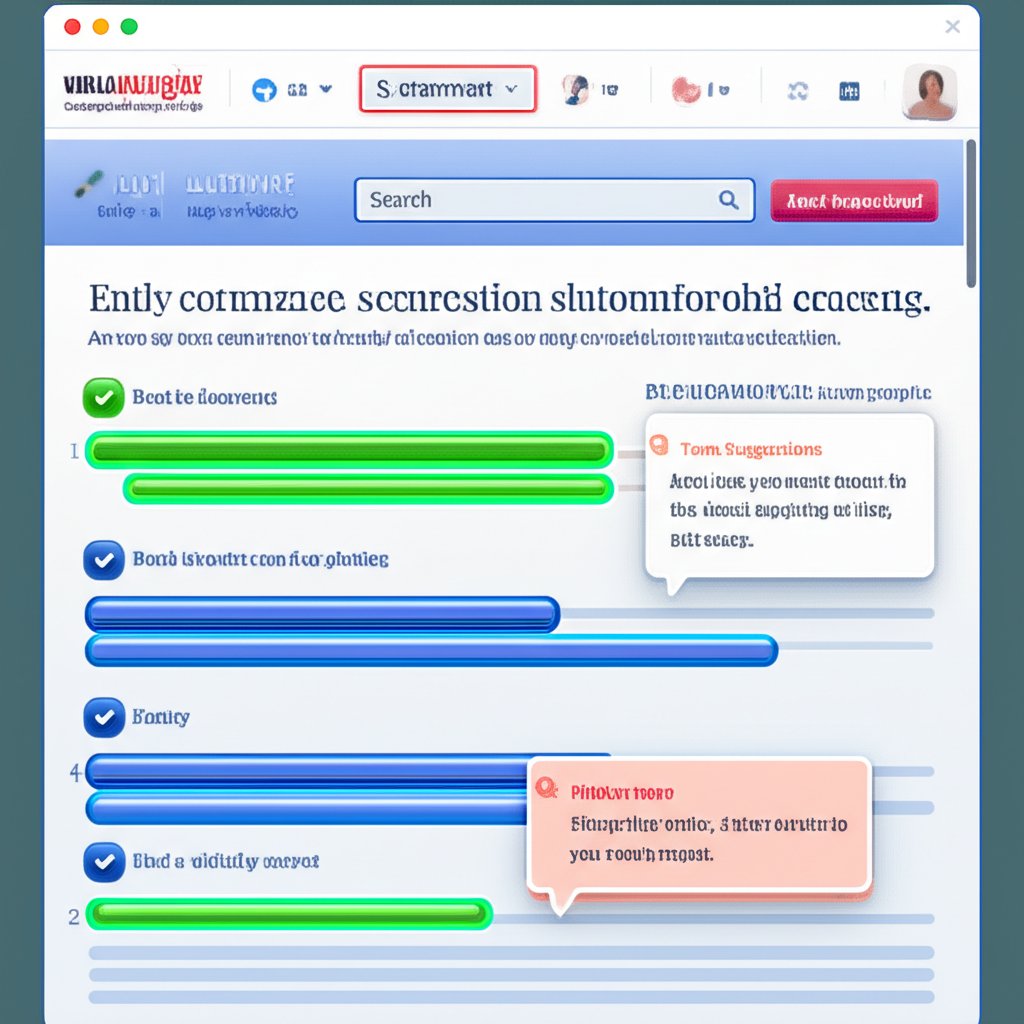Get results from blog content writing tips now
When you search for blog content writing tips, do you ever feel overwhelmed by generic advice and endless checklists? Sounds complex? You’re not alone. In 2025, the digital landscape is more competitive than ever, and most blogging tips simply don’t deliver outcomes—especially for those seeking real growth. This guide flips the script: it’s a practical, tools-first workflow designed to help you turn ideas for a blog into published, ranking posts—faster and smarter.
Why most blogging tips fail in 2025
Let’s be honest: the old playbook of “just write quality content” isn’t enough. Google’s AI-powered algorithms now reward depth, authority, and user intent, not just surface-level optimization or catchy headlines. Many blogging tips for beginners overlook the real blockers that keep creators from hitting publish consistently. If you’ve struggled to move from blogging ideas to actual results, you’re not alone.
- Time crunch: Finding hours to research, outline, write, and optimize every week is tough.
- Workflow chaos: Without a clear process, posts get stuck in drafts or miss SEO essentials.
- Analysis paralysis: Too many tools and strategies lead to indecision and stalled progress.
This guide removes those blockers by focusing on proven, ROI-driven tools that streamline every step—from ideation to publication. Each tool featured here is selected for its ability to:
- Accelerate blogging ideas and topic discovery
- Structure smarter outlines and briefs
- Automate on-page SEO and readability checks
- Enhance visuals and editorial workflows
What great posts do differently
Imagine you could publish more blogs to write in less time, with each post optimized for search and reader engagement. That’s what separates average blogs from those that earn traffic and trust. The difference? A repeatable process, supported by the right mix of AI and human creativity. You’ll notice that every product in this list includes a quick pros and cons breakdown, best use cases, and a mini framework so you can apply each tip immediately—no guesswork, just results.
Here’s the key takeaway: Focus on search intent, clear structure, and iterative optimization. That’s the foundation for sustainable blog growth in 2025.
The tools that speed up quality
Whether you’re looking for blogging advice on research, outlining, drafting, or editing, you’ll find actionable solutions here. Tools like the AI Blog Post Generator help you ideate, structure, and optimize every article for both search and readers. Our selection favors features that prove ROI—think research, outlines, on-page SEO, readability, visuals, and editorial ops—so you can focus on what matters most: publishing consistently and growing your audience.
- Use bullet lists for quick wins and actionable takeaways as you read
- Follow numbered steps for each tool’s workflow to apply tips right away
Ready to compare the best tools side by side? This guide includes a detailed comparison table and a clear final recommendation with next steps, so you can confidently choose your stack and start seeing results from your blog content writing tips.

Methodology and repeatable SEO workflow explained
Ever wonder why some blogs consistently rank well while others struggle to gain traction? The difference often comes down to a clear, repeatable workflow and a commitment to blog writing best practices. Here’s how we evaluated the top tools and built a workflow any team can use to turn blog writing tips into measurable results.
Evaluation criteria and scoring
When assessing tools for seo blog writing, we focused on the factors that directly impact search visibility and content quality. Each tool was scored on:
- Relevance: Does the tool help address the user’s prompt and search intent?
- Accuracy: Are outputs factually correct and trustworthy?
- Originality: Does it help create unique, valuable content?
- Structure & Organization: Can it produce a logical blog post outline and support a clear blog post format?
- SEO Friendliness: Does it guide on keyword usage, headings, and meta data?
- Readability: Are outputs easy to scan and understand?
- Visuals & Media: Can you add images or prompts for media?
- Ease of Use & Speed: How quickly can you go from idea to draft?
- Cost Efficiency: Does the value justify the investment?
For example, Surfer’s content score and Grammarly’s grammar-checking were both evaluated for their impact on blog post best practices.
SEO workflow from keyword to publish
Sounds complex? Here’s a step-by-step workflow you can use for every post, whether you’re a solo creator or part of a team:
- Keyword research: Use tools to identify topics and target keywords with the right balance of search volume (SV) and keyword difficulty (KD).
- Intent mapping: Clarify what readers expect—informational, how-to, or transactional.
- Brief and outline: Draft a clear structure, including headings and subpoints.
- Draft: Write your post, focusing on value and clarity.
- On-page SEO: Optimize titles, meta descriptions, and headings; add keywords naturally.
- Internal links: Link to pillar and related posts to boost topic authority.
- Visuals: Add images, charts, or screenshots with descriptive alt text.
- Publish: Double-check formatting and go live.
- Measure: Track rankings, clicks, and engagement.
- Refresh: Update older content to keep it relevant.
| Keyword | SV | KD | Intent |
|---|---|---|---|
| blog writing tips | 320 | 41 | Informational |
| blog post outline | 140 | 36 | Informational |
| seo blog writing | 590 | 47 | Informational |
Editorial SOP and QA checklist
To keep your process efficient, build a simple editorial Standard Operating Procedure (SOP). Assign roles (writer, editor, publisher) and set due dates for each stage. Before publishing, run through this pre-publish QA checklist:
- Primary keyword in title, H1, and first paragraph
- Compelling meta description (under 155 characters)
- Logical H1-H3 structure for scannability
- Short paragraphs and bullet points for readability
- Descriptive, keyword-rich image alt text
- Clean, SEO-friendly URL (use hyphens, avoid stop words)
- Internal links to pillar and cluster pages
- External links to authoritative sources
After publishing, promote your post using these steps:
- Share on social media platforms
- Email to your subscriber list
- Submit to relevant communities or forums
- Monitor performance and engage with comments
Internal linking and topic clusters
Internal links are essential for guiding readers and signaling content relationships to search engines. For a quick audit, check that each new post:
- Links to at least two relevant older posts
- Includes a link to a pillar or cluster page
- Uses descriptive anchor text (not just "click here")
Organize your content into topic clusters—groups of related posts that link to a central pillar page. This structure supports better rankings and a more intuitive blog post format for readers.
According to The Blogsmith, following a detailed on-page SEO checklist and establishing a repeatable workflow are proven ways to improve content quality and search rankings.
With this methodology and workflow, you’ll have a foundation for consistent, high-quality publishing—making it easier to adopt new blog writing tips and adapt to evolving blog best practices. Next, we’ll explore how the right tools can help you execute this process even faster and with greater accuracy.

BlogSpark AI
Ever wished you could go from blog outline to published post in a fraction of the time—without sacrificing quality or SEO? Imagine a tool that takes you from idea to optimized draft in minutes, not hours. That’s where BlogSpark stands out as the go-to choice for anyone serious about blog content writing tips that drive real results. Whether you’re a solo creator or managing a team, BlogSpark’s AI Blog Post Generator is built for speed, control, and SEO impact.
Quick take and standout features
- 1 click blog post generation from a single topic or keyword
- Instant, SEO-focused blog outline and section suggestions
- Integrated keyword research and search intent mapping
- Brand voice memory for consistent tone and messaging
- On-page SEO optimization, readability checks, and originality scan
- Flexible export and direct WordPress integration
With BlogSpark, you’ll notice how to write blog posts faster becomes second nature. It’s not just about speed—each output is structured to help you learn how to write a good blog that ranks and converts.
Your tips to get results with BlogSpark
- Research: Start with a keyword or trending topic—BlogSpark’s AI suggests related terms and search intent.
- Outline: Use the automated how to write a blog post outline feature to build a logical, SEO-friendly structure.
- Draft: Generate section-by-section content, customizing tone and length as needed.
- Optimize: Run the built-in SEO checker for headings, meta tags, and keyword placement.
- Publish: Export directly or sync with your CMS for a seamless workflow.
Want to know how to write a great blog that stands out? BlogSpark’s process ensures every draft is ready for both readers and search engines.
Pros and Cons
Pros
- Lightning-fast briefs and outlines tailored to search intent
- Integrated SEO suggestions for every section
- Consistent brand voice across all posts
- Originality and readability checks built-in
Cons
- Requires clear, specific inputs for best results
- Advanced SEO features may need a short learning curve
Best use cases
- Informational guides and evergreen resources
- Comparison posts and product roundups
- Refreshing or expanding underperforming content
If you’re wondering how to write a post that consistently delivers value, BlogSpark’s workflows are designed to help you get there.
Mini case study
In Q2 2025, a B2B SaaS used BlogSpark to produce 12 posts in 4 weeks. Results in 60 days: +148% organic sessions, 9 keywords to top 3, email signups +41%. Key changes: tighter outlines, FAQ schema, and better internal links.
- Seed your outlines with real SERP headings for relevance
- Expand sections using expert quotes or data to boost authority
- Interlink to cluster pages immediately for better topical depth
When you’re ready to move from how to write a good blog to how to write a great one, the right tool makes all the difference. BlogSpark empowers you to turn blog content writing tips into a repeatable, scalable process. Next, we’ll see how other AI tools stack up for long-form drafting and team workflows.
Jasper AI
Ever stared at a blank page, wishing you could kickstart a blog post with just a few prompts? Jasper AI is designed to solve that problem—especially for teams or creators who want to produce long-form content faster, but still need control over structure and tone. If you’re looking for tips for writing blog posts that actually scale, Jasper’s combination of templates, tone customization, and collaborative features makes it a compelling option in your content toolkit.
Quick take and standout features
- Rapid idea-to-draft workflow: Generate a full draft from just a topic and a few prompts
- Flexible templates: From blog outlines to listicles, case studies, and even FAQs
- Brand voice memory: Upload a sample or URL to match tone (though results may vary)
- Multi-language support for global teams
- Integrations: Built-in Grammarly and Copyscape, plus Surfer SEO (with subscription)
Jasper shines when you need to brainstorm, structure, and draft quickly—especially for thought-leadership pieces or repurposing webinar notes. But, as with any AI tool, it’s most effective when paired with a clear workflow and human oversight.
Your tips to get results with Jasper
- Import your brief: Start by pasting your topic, target audience, and tone into Jasper’s template or long-form assistant.
- Outline with clear H2/H3s: Use Jasper’s outline template to map your structure—think bullet lists for quick wins, and numbered steps for in-depth guides.
- Draft per section: Generate content one section at a time. This keeps paragraphs focused and under 120 words, boosting readability and SEO.
- Insert stats and sources: Manually add authoritative data or expert quotes to strengthen credibility.
- Run a separate SEO pass: Use Surfer or another tool to optimize headings, keywords, and meta data before publishing.
Tip: Always fact-check AI-generated claims and cite primary research. While Jasper can accelerate drafting, your expertise ensures accuracy and trust (Authority Hacker).
Pros and Cons
Pros
- Speeds up first drafts and brainstorming
- Customizable tone and multi-language support
- Templates for various blog formats and use cases
- Collaboration tools for teams
Cons
- Occasional generic output or fluff—requires manual editing
- Weaker on-page SEO guidance compared to dedicated SEO tools
- Brand voice feature can be inconsistent
- Higher price point than some alternatives
Best use cases
- Thought-leadership or opinion drafts
- Listicles and quick-turnaround posts
- Repurposing webinar notes or interviews
- Drafting FAQs or product descriptions
For writing tips for blogs that need to be applied across a team, Jasper’s collaborative features and structured templates help maintain consistency. Still, it’s best used as an assistant—not a replacement for human research or editing.
Checklist: Factual accuracy and brand alignment
- Verify all statistics and claims with reputable sources
- Review tone and language for brand consistency
- Edit for clarity and conciseness—keep paragraphs short
- Ensure SEO elements (title, H1, meta) are optimized separately
In summary, Jasper is a powerful drafting aid for those who want to speed up content creation without losing the human touch. By following these tips for writing blogs—like locking in your intro angle, structuring with clear headings, and editing for accuracy—you’ll get the most from AI while delivering posts readers and search engines will trust. Next up, we’ll see how tools like Grammarly can polish your drafts for clarity and engagement.

Grammarly Editor
Ever finished a draft and wondered if your message is clear or if your tone fits your audience? When you’re juggling deadlines and striving to improve your blog writing style, clarity and tone can make or break your post’s impact. That’s where Grammarly comes in—a tool trusted by writers and editors to polish drafts, enforce guidelines for writing, and ensure every sentence lands just right.
Quick take and standout features
- Real-time grammar and spelling checks: Instantly flags errors and suggests fixes as you write.
- Tone rewrites and analysis: Adjusts language to match your intended audience, making tips for selecting blog post tone actionable with a single click.
- Conciseness and clarity suggestions: Identifies wordy or vague sentences, helping you write tighter, more effective posts.
- Plagiarism checker: Scans your content against billions of web pages for originality.
- Customization: Personalize settings for your brand’s voice and preferred terminology.
Readability lifts time-on-page and scroll depth. Clear, concise writing encourages readers to stay engaged and take action.
Your tips to get results with Grammarly
- Toggle tone for audience fit: Use Grammarly’s tone detector to ensure your writing matches your readers—whether you want to be friendly, formal, or direct.
- Keep sentences under 20 words: Short sentences improve skimmability and comprehension—an essential tip for a good blog.
- Run a final pass after adding stats and quotes: Ensure facts and citations flow naturally and are error-free.
- Draft your post, focusing on your main points and structure.
- Run Grammarly to catch grammar, spelling, and tone issues.
- Restore essential jargon or expert terms if needed—don’t let over-simplification dilute your message.
- Re-check headings and subheadings for clarity and consistency.
- Do a final read-out-loud test to catch awkward phrasing or shifts in tone.
Pros and Cons
Pros
- Robust grammar and spelling correction in real time
- Tone adjustment features for audience alignment
- Conciseness suggestions for tighter writing
- Plagiarism checks for originality assurance
Cons
- May over-simplify technical or expert terms—review changes for accuracy
- Occasional stylistic rigidity; not all suggestions fit every blog writing style
Best use cases
- Editorial polish for all blog content, from headlines to conclusions
- Maintaining multi-author consistency across a content team
- Improving intros and conclusions that often ramble or lose focus
- Applying tips on writing blog posts for clarity and engagement
Imagine you’re editing a guest post: Grammarly helps you spot tone mismatches, vague claims, and long-winded sentences—making it easier to apply selecting blog post tone tips and keep your content sharp. For anyone serious about blog content writing tips, incorporating Grammarly into your workflow means every post is clearer, more engaging, and ready for publishing.
Next, we’ll explore how on-page SEO tools can further optimize your content for search and reader satisfaction.
Surfer SEO
Ever wondered why some blog posts skyrocket to the top of Google while others languish on page two? When you’re serious about how to write blogs for SEO, it’s not just about great writing—it’s about matching what works in the search results, filling in content gaps, and optimizing every detail. That’s where Surfer SEO shines as your on-page co-pilot, giving you actionable data and structure to turn blog writing tips for SEO into real-world rankings.
Quick take and standout features
- Data-driven recommendations: Surfer analyzes the top-ranking pages for your target keyword and reveals exactly which terms, headings, and word counts are driving results.
- Content Editor: Get real-time feedback on keyword usage, structure, and content score as you write—making it easy to see how to write SEO friendly blog post drafts that align with what’s working now.
- Competitor gap analysis: Instantly spot missing terms, questions, or sections compared to the best-performing posts—no more guesswork.
- Customizable guidelines: Tweak word count, H2/H3 count, and focus terms to fit your brand, audience, and search intent.
- Content score tracking: Watch your optimization progress in real time, so you know when your post is ready to publish.
Your tips to get results with Surfer
- Prioritize intent-matched terms: Focus on keywords and phrases that top-ranking competitors use for your target query—this is crucial for blog writing for websites that want to rank for competitive topics.
- Add information gain: Don’t just copy what’s out there—bring in original insights, fresh data, or unique examples to give readers (and search engines) a reason to choose your post.
- Cap your H2 count: Too many subheadings can dilute focus and overwhelm readers. Surfer helps you match the optimal structure for your keyword—often, fewer, more targeted H2s win.
- Analyze the SERP: Enter your keyword and location in Surfer; review the top five organic competitors to benchmark structure and intent.
- Finalize your outline: Use Surfer’s AI outline generator and competitor data to build a logical, search-optimized plan—think of this as your roadmap for how to write good blog posts that actually rank.
- Draft your content: Write inside the Content Editor, following Surfer’s live term suggestions and structure guidelines.
- Optimize headings and terms: Adjust H2s, refine keyword placements, and fill any content gaps flagged by Surfer.
- Add internal links: Use Surfer’s audit tool to spot and insert relevant links to pillar or cluster pages, boosting topical authority.
Pros and Cons
Pros
- Data-driven terms and structure tailored to your keyword
- Competitor gap analysis for actionable improvements
- Real-time content score and optimization feedback
- Customizable guidelines for brand and topic fit
Cons
- Risk of over-optimization if you blindly follow every suggestion
- Some outputs can feel generic—always add your unique voice
- Requires human editorial judgment for best results
Best use cases
- Refreshing underperforming blog posts with targeted keyword and structure updates
- Launching new posts in competitive niches where every ranking factor counts
- Building content clusters and pillar pages that dominate search results
- Training teams on how to optimize a blog post for SEO with clear, repeatable processes
Mini case study
An ecommerce blog refreshed 8 posts with Surfer in 30 days; average content score rose from 54 to 73, resulting in +62% clicks and 5 new top-10 rankings by day 45.
Pair Surfer’s optimization workflow with your own expertise—review every suggestion, weave in expert quotes, and always check for originality to meet E-E-A-T (Experience, Expertise, Authoritativeness, Trustworthiness) standards. That’s the secret to turning blog content writing tips into posts that not only rank but provide real value to your audience.
Ready to take your blog writing for websites to the next level? Up next, we’ll show how visual content tools can further boost engagement and search performance.

Canva Visuals
Ever wondered how to present a blog so it instantly grabs attention and keeps readers scrolling? In today’s content landscape, visuals are more than decoration—they’re essential for boosting engagement, social shares, and time-on-page. With Canva, even non-designers can create professional graphics that elevate the format of a blog post and make every article stand out.
Quick take and standout features
- Intuitive drag-and-drop editor: No design experience needed—start with thousands of templates tailored for blog headers, social posts, and infographics (The Blog Social).
- Brand kit tools: Save your logo, brand colors, and fonts for consistent visuals across every post.
- Charts and diagrams: Quickly visualize data or concepts to make complex ideas easier to digest.
- AI-powered design suggestions: Get smart recommendations for layouts, fonts, and color palettes tailored to your niche.
- SEO-friendly image export: Save graphics in WebP or compressed formats to ensure fast load times and better search rankings.
Canva’s versatility means you can create everything from feature images and annotated screenshots to custom infographics—perfect for any example of a blog format you want to achieve.
Your tips to get results with Canva
- Design a consistent blog header style: Use Canva’s templates and brand kit to ensure every post starts with a recognizable, on-brand header.
- Use annotated screenshots for how-tos: Highlight steps or features directly on images to guide readers visually—this works wonders for tutorials and walkthroughs.
- Compress images for speed: Export graphics as WebP and keep file sizes under 200KB. This reduces load times and improves your blog’s Core Web Vitals.
- Pick a brand template or create one from scratch in Canva.
- Create a cover image and social sharing graphics for each post.
- Insert explanatory diagrams or charts to clarify complex points.
- Export images in WebP format for web use.
- Add descriptive, keyword-rich alt text to every image for accessibility and SEO.
Align each visual with your H2 headings and place the first image above the fold. This not only draws readers in but also signals quality and relevance to search engines.
Pros and Cons
Pros
- Brand kits for visual consistency across all posts
- Extensive template library for every blog need—headers, featured images, infographics, and more
- Easy-to-use annotation tools for step-by-step guides
- Supports modern image formats (WebP, PNG, JPG) for optimized performance
- Collaborative features for team-based content creation
Cons
- Large, uncompressed images can slow your site if not exported properly
- Template sameness—overuse of popular layouts can make your blog look generic if not customized
Best use cases
- Creating blog headers and featured images that match your brand identity
- Designing infographics and charts to visualize key data
- Producing step-by-step image guides for tutorials
- Building social sharing graphics to boost post visibility on platforms like Pinterest and Instagram
Wondering what does a blog look like when visuals are done right? Scan top-performing posts in your niche—they consistently use custom graphics to break up text, clarify points, and encourage sharing. Canva empowers you to do the same, regardless of your design background.
By mastering Canva, you’ll not only improve the appearance of your blog but also support better SEO and user experience. Next, we’ll look at how to organize your content workflow and editorial calendar for maximum publishing consistency.
Notion Editorial Calendar
Ever feel like your blog content creation process is scattered across endless docs, emails, and spreadsheets? When you’re juggling briefs, outlines, and deadlines—especially when writing blogs for companies or managing a team—the right workspace can make all the difference. That’s where Notion stands out: it transforms content chaos into an organized, repeatable workflow that keeps everyone on track.
Quick take and standout features
- All-in-one workspace: Combine briefs, outlines, checklists, editorial calendars, and KPI dashboards in a single, searchable hub.
- Templates and databases: Save time with reusable blog post outline templates and topic cluster databases—perfect for tracking post ideas for blog campaigns or recurring series.
- Cross-linking and collaboration: Link related notes, assign tasks, and set due dates so everyone knows their next step.
- Content calendar: Visualize your publishing schedule, track status, and avoid missed deadlines.
- Custom KPI blocks: Embed plain-text dashboards to monitor impressions, clicks, rankings, and conversions at a glance.
Imagine never having to ask, “Where can you find blogs in progress?”—because everything lives in one place, updated in real time.
Your tips to get results with Notion
- Maintain a master topic cluster database: Organize all your blog content creation ideas and map internal links for SEO authority.
- Store a reusable blog post outline template: Standardize structure and ensure every post follows best practices, whether for solo work or writing blogs for companies.
- Create a post-publish promotion checklist: Document every step for sharing, repurposing, and updating posts to maximize reach.
Editorial SOP: A Step-by-Step Workflow
- Intake brief: Capture the topic, objectives, and key SEO targets in Notion.
- Outline in Notion: Use your template to map headings, subpoints, and sources.
- Drafting: Write directly in Notion or link to your preferred editor.
- SEO QA: Check for keyword placement, meta data, and readability.
- Internal links: Add links to relevant posts and cluster pages—essential for building blogging skills and boosting rankings.
- Promotion: Follow your checklist for social, email, and community outreach.
- 30/90-day refresh tasks: Schedule content updates to keep posts current and competitive.
Pros and Cons
Pros
- Flexible templates and databases for all stages of content ops
- Transparent task assignment and due dates for accountability
- Easy cross-linking for topic clusters and related posts
- Centralized calendar and KPI tracking—no more scattered spreadsheets
Cons
- Initial setup can take time, especially for large teams
- Permissions and access management may get complex at scale
Best use cases
- Managing multi-author blogs or agency content pipelines
- Tracking post ideas for blog series and seasonal campaigns
- Maintaining a living editorial calendar with real-time status updates
- Building a knowledge base for onboarding and ongoing blogging skills development
- Answering the question, "where can you post blogs and keep them organized for future refreshes?"
Mini case study
A startup created a Notion pipeline and increased publish velocity from 2 to 6 posts/month; in 90 days, organic clicks grew 83% with consistent internal linking and weekly refreshes.
For teams or solo creators serious about scaling blog content creation, Notion’s flexible workspace removes bottlenecks and supports repeatable, high-quality publishing. Embedding a simple KPI dashboard (impressions, clicks, rankings, conversions) makes it easy to measure what matters and iterate fast. Next, we’ll compare all the top tools side-by-side so you can choose the best stack for your workflow and goals.
Comparison Summary
When you’re ready to put blog content writing tips into action, the right tool stack can make or break your results. But with so many options—each promising the best blogging tips or the fastest workflow—how do you decide? Let’s break down the top platforms side by side so you can match their strengths to your unique needs, whether you’re searching for the best blog writing tips, the best blog topics, or simply want to know how to make a successful blog in 2025.
Feature-by-Feature Comparison
| Tool | Key Features | SEO Assistance | Collaboration | Best For | Rating |
|---|---|---|---|---|---|
| BlogSpark | 1-click outlines & drafts, integrated SEO, brand voice, originality check | Built-in keyword, outline, and on-page SEO suggestions | Team roles, export, WordPress sync | Fast, SEO-optimized publishing for all levels | 4.8/5 |
| Jasper AI | Templates, long-form drafts, brand tone, Surfer SEO integration | SEO via Surfer integration, content templates | Collaboration, comments, multi-language | Teams, marketers, content scale | 4.6/5 |
| Surfer SEO | Content editor, SERP analysis, keyword gap, content score | Advanced on-page SEO, live content scoring | Limited (solo or add-on to other tools) | SEO pros, content refresh, optimization | 4.7/5 |
| Grammarly | Grammar, clarity, tone, plagiarism checker | Readability, tone, and clarity (not keyword SEO) | Multi-author, brand style guides | Editing, brand consistency | 4.7/5 |
| Canva | Design templates, brand kits, charts, image export | Visual SEO (alt text, image compression) | Shared folders, comments | Visual content, branded graphics | 4.8/5 |
| Notion | Editorial calendar, templates, databases, KPI dashboard | Workflow and topic cluster organization | Real-time team collaboration | Content ops, multi-author blogs | 4.7/5 |
Pricing and ROI Snapshot
Most tools offer free trials or entry-level plans, so you can test which delivers the top blogging tips for your workflow. For rapid publishing and integrated SEO, BlogSpark’s ROI often shines for both beginners and pros. Jasper and Surfer are excellent for scaling content or deep optimization, while Grammarly and Canva are must-haves for polish and engagement. Notion ties it all together for operational consistency—essential for the best blogs 2024 and beyond.
Best Fit by Use Case
- BlogSpark: End-to-end blog creation, from idea to publish—ideal for anyone wanting the best blog writing tips in one place.
- Jasper: Long-form drafts and collaborative team workflows.
- Surfer SEO: On-page optimization and content refreshes.
- Grammarly: Editorial polish, clarity, and tone consistency.
- Canva: Visual content and branded graphics for every post.
- Notion: Editorial planning, content calendar, and team ops.
Key Takeaways
- Speed-to-publish is crucial—choose tools that streamline research, drafting, and optimization.
- On-page SEO quality sets the foundation for ranking—prioritize platforms with built-in or integrated SEO guidance.
- Team workflows and collaboration features are essential for scaling and maintaining consistency.
To avoid tool overload, pick one primary tool and two supporting tools that match your bottlenecks—whether that’s research, writing, editing, visuals, or operations.
Every blog is unique, and the best blog ideas or best blog topics for your audience may require a different mix. Test your chosen stack for 14–30 days, measure traffic, engagement, and publishing speed, and adjust as needed. That’s how you’ll build the workflow behind the best blogs 2024—and set yourself up for long-term success.
Scale Your Blog With the Right Tools and Action Plan
When you’re ready to turn blog content writing tips into measurable growth, the real question becomes: which tool should you use first, and how do you build momentum? Imagine you’re launching a new site or revamping an existing one—what’s the fastest, most reliable way to how to build traffic to your blog and keep readers coming back?
Best Pick by Use Case
- Fastest first draft: AI Blog Post Generator (BlogSpark)
- Tight SEO optimization: Surfer SEO
- Polish and tone: Grammarly
- Visuals: Canva
- Operations and content calendar: Notion
- Long-form ideation: Jasper AI
If you’re wondering how to start a blog for beginners or what to blog about to attract your ideal audience, start with BlogSpark. Its guided workflows help you move from blank page to optimized draft in one sitting—perfect for anyone looking to get results at scale.
Consistency + intent + refreshes outperform sporadic publishing. Focus on building a repeatable process, and you’ll see compounding results over time.
Your Tips for Immediate Wins
- Use a standard outline for every post—this saves time and ensures what makes a good blog is always top of mind.
- Map internal links as you draft to boost SEO authority and help readers discover more content.
- Repurpose your best-performing posts into visuals and social snippets to how to get people to read your blog beyond search.
- Set clear, actionable goals for each post—traffic, signups, or engagement—so you can measure real impact.
- Document your workflow and build a living SOP as you go. This makes it easier to train new contributors or scale up production.
Next Steps and KPI Targets: Your 14-Day Launch Plan
- Set goals and baselines: Define what success looks like (traffic, signups, rankings, etc.).
- Publish 2–4 posts: Use a repeatable outline from BlogSpark for each article.
- Add internal links: Connect every new post to a pillar or cluster page.
- Compress images and finalize alt text: Ensure fast load times and accessibility.
- Submit to Search Console: Index your new content for faster discovery.
- Review metrics weekly: Track impressions, clicks, and conversions against your baseline.
- Schedule 30-day refresh tasks: Plan to update and improve posts based on performance.
Not sure how to end a blog post or keep your process sustainable? Close each article with a clear call to action, and revisit your workflow regularly to capture new what to blog about ideas and lessons learned. Remember, the best way to how to write a great blog is to combine intent, structure, and iteration—using the right tools as your foundation.
Ready to scale? Start with the AI Blog Post Generator as your central hub—then add supporting tools as your needs grow. Document your wins, measure what matters, and build a stack that evolves with your goals. That’s the proven path to blog growth in 2025 and beyond.
Frequently Asked Questions About Blog Content Writing Tips
1. What are the most common mistakes beginners make in blog content writing?
Beginners often overlook search intent, lack a consistent structure, and neglect on-page SEO essentials. Using a clear workflow and the right tools can help address these issues, ensuring your posts are both engaging and optimized for search engines.
2. How can I quickly generate blog post ideas that are SEO friendly?
Leverage AI-powered tools like BlogSpark to discover trending keywords and topics with high search potential. Focus on topics that match your audience's intent and use these insights to craft outlines that are both valuable and SEO optimized.
3. What is the best way to structure a blog post for readability and SEO?
Start with a compelling title and introduction, use clear H1-H3 headings, and organize content with short paragraphs and bullet points. Integrate relevant keywords naturally, add internal links, and enhance posts with visuals for improved engagement and search performance.
4. Which tools can help me streamline my blog writing workflow?
BlogSpark offers end-to-end blog creation with integrated SEO, while Surfer SEO specializes in on-page optimization. Grammarly ensures clarity and tone, Canva enhances visuals, Notion manages editorial calendars, and Jasper AI accelerates long-form drafting.
5. How should I measure the success of my blog content writing efforts?
Track key metrics such as organic traffic, keyword rankings, engagement rates, and conversions. Set clear goals for each post, use tools to monitor progress, and regularly refresh content to maintain and improve search visibility.




